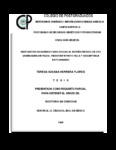| dc.description.abstract | Existen indicadores bioquímicos, fisiológicos, morfológicos y fenológicos de la
respuesta de las plantas al déficit de humedad, que pueden ser utilizados de
manera práctica por los fitomejoradores, con el fin de optimizar la selección de
plantas tolerantes al estrés en diferentes cultivos agrícolas. El objetivo principal
fue: evaluar el efecto del déficit hídrico sobre la elongación, y la acumulación de
biomasa y de compuestos bioquímicos en la radícula y en las hojas de las
variedades Pinto Villa resistente y Bayo Madero susceptible a la sequía. La
investigación se dividió en tres fases; en la primera, se estudió el efecto del estrés
hídrico en la elongación y la acumulación de biomasa en la radícula, así como la
cuantificación de la concentración de solutos compatibles en la segunda fase y, en
la tercera además de los solutos compatibles, también se midió la actividad de la
enzima ascorbato peroxidasa en las hojas. Algunos de los resultados
sobresalientes, fueron: se observaron diferencias significativas en la elongación de
la radícula entre las dos variedades; Pinto Villa tuvo mayor elongación tanto en el
potencial de mayor estrés -2.07 MPa con 5.28 cm, como en el de menor -0.16
MPa con 14.85 cm, que Bayo Madero 5.09 y 12.27 cm respectivamente. En
cuanto a la redistribución de la biomasa inicial de la semilla a las diferentes
estructuras de la misma durante la germinación, no se observaron diferencias
entre las dos variedades en el porcentaje relativo al peso inicial de la biomasa en
cada estructura (cotiledón + plúmula, radícula y testa) aún cuando Bayo Madero
tiene mayor tamaño de semilla que Pinto Villa. Se observaron diferencias
significativas en la concentración de prolina, Pinto Villa tuvo 691.57 nm·g¯¹pf,
mientras que Bayo Madero 486.85 nm·g¯¹pf en el potencial de mayor estrés -2.07
MPa; en la concentración de carbohidratos también hubo diferencias significantes,
siendo la sacarosa el que se concentró en mayor cantidad. En la última fase se
observó una disminución de la concentración de solutos compatibles en las hojas
con respecto a la radícula, aún así, se observaron diferencias significativas entre
las variedades en la concentración de prolina en las hojas, Pinto Villa fue superior
a Bayo Madero, mientras que la concentración de carbohidratos fue más alta en
Bayo Madero que en Pinto Villa. La mayor concentración de ácido ascórbico y la
actividad de la enzima ascorbato peroxidasa se tuvo en la 1ª y 2ª hojas
trifolioladas respectivamente en Pinto Villa con respecto a Bayo Madero, lo que
indica que Pinto Villa tiene mayor concentración de ácido ascórbico en etapas más
tempranas de su desarrollo que Bayo Madero. En base a los resultados anteriores
se confirma la hipótesis de que Pinto Villa tiene mayores niveles de los indicadores
bioquímicos relacionados con la respuesta de mayor tolerancia al estrés de
humedad que Bayo Madero.________There are biochemical, physiological, morphological and phenological indicators of
the responses of plants to water deficit, which can be used in a practical manner by
breeders, in order to optimize the selection of tolerant plants to stress in different
agricultural crops. The main objective of this study was to assess the effect of
water deficit on the elongation, biomass accumulation and biochemical compounds
in the radicle and in the leaves of two common bean varieties Pinto Villa resistant
and Bayo Madero drought susceptible. The research was divided into three
phases, in the first it was studied, the effect of water stress on the elongation and
the accumulation of biomass in the radicle, as well as the quantification of the
concentration of compatible solutes in the second phase; and in the third, in
addition to the compatible solutes, was also measured the activity of the enzyme
ascorbate peroxidase in the leaves. Some of the main results were: significant
differences were observed between the two varieties in the elongation of the
radicle; Pinto Villa had more elongation (5.28 cm) in the water potential of higher
stress -2.07 MPa, while in the potential -0.16 MPa of lower stress the elongation of
the radicle was 14.85 cm as compared with Bayo Madero whose radicle had an
elongation of 5.09 and 12.27 cm respectively on the same conditions of water
potential. Regarding to the redistribution of the initial biomass of the seed to it
different structures during germination, there was no difference between the two
varieties in the percentage of biomass relative to the initial weight in each structure
(cotyledon + plumule, radicle and testa) in spite that Bayo Madero has larger seeds
than Pinto Villa. There were significant differences in the concentration of proline
between the varieties, Pinto Villa had 691.57 nm·g·¯¹pf, while Bayo Madero 486.85
nm·g·¯¹pf at the water potential for higher stress -2.07 MPa. Regarding the
concentration of carbohydrates there were significant differences too, between
Pinto Villa and Bayo Madero, being sucrose concentrated in larger quantities. In
the last phase of the study there was observed a decrease in the concentration of
compatible solutes in the leaves with respect to the radicle, even though significant
differences on the concentration of proline in the leaves were observed between
the two varieties, Pinto Villa outweigh Bayo Madero while carbohydrate
concentration was higher in Bayo Madero compared with Pinto Villa. The
concentration of ascorbic acid and the activity of the enzyme ascorbate peroxidase
were higher in the 1st and 2nd trifoliolate leaves on Pinto Villa with respect to Bayo
Madero, suggesting that Pinto Villa accumulate a higher concentration of ascorbic
acid at earlier stages of its development as compared with Bayo Madero. The
results presented before serve as basis to accept the hypothesis that Pinto Villa
have higher levels of biochemical indicators related to its response of tolerance to
moisture stress in relation to Bayo Madero. | es |

